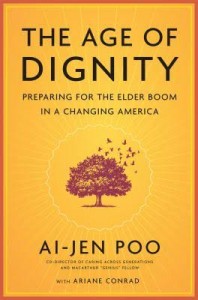 Ai-Jen Poo is the director of the National Domestic Workers Alliance (NDWA) and a co-director of Caring Across Generations.
Ai-Jen Poo is the director of the National Domestic Workers Alliance (NDWA) and a co-director of Caring Across Generations.
Given these roles and her work advocating for better protections for care workers, it’s not surprising that Poo’s approach to discussing the consequences and opportunities of the elder boom is framed around the experiences of this often overlooked group within the labor force.
In The Age of Dignity: Preparing for the Elder Boom in a Changing America, Poo illustrates her points with personal stories from the caregiving experiences of her own family and those of personal care workers she has met through her advocacy work. These stories show the dedication of the workers, the good and bad situations they find themselves in, and the skills and expertise required to do the job.
They also show how domestic work – informal and professional – is undervalued.
An estimated 2 million people work as in-home caregivers in the United States. They care for the most costly clients in our health care system, allowing them to remain at home as most would prefer. They are first responders in a disaster and they support the families as well as the care recipient.
Most of these workers are women. About 2/3 are immigrants and about 1/2 of those are undocumented. They earn on average less than $10/hour. Few have employer-provided health insurance, pensions, or paid vacation or sick leave. This is for work that can be rewarding, and is certainly important, but it also physically and emotionally challenging.
It’s no wonder that there is high turnover in these jobs. And high turnover leads to poor quality care.
At the same time, home care workers are the fastest growing part of the workforce. They are a key component of our long term care system where the number of older adults is increasing and relying on informal caregivers is not sustainable.
Poo uses stories and data to put forth a compelling set of recommendations for the future all of which lead to an infrastructure for care that she calls a Care Grid. She notes past investments we have made in infrastructure when there was a national need and the leaps in technological and social innovations that resulted – think railroads, interstate highways, electricity, the Internet.
She also looks to international examples of such an investment like Japan and Germany who are head of us in the elder boom. Both countries instituted universal long-term care insurance that led to better care, reduced dependence on social assistance, and expanded growth of private sector long-term care services. In Japan’s case, the system was implemented during an economic recession.
So what’s stopping us from making this investment? If we’re willing to invest in highways because we see the national benefit why do we so undervalue the people who care for our loved ones (and someday us)?
The care infrastructure (or the lack of it) has a direct impact on the quality of care provided. And, since money seems to speak most loudly, the development of such an infrastructure is a huge economic opportunity.
But it requires investment, long-term thinking, and delayed gratification – things that seem to be in short supply right now. And it requires valuing this kind of work – something that requires a fundamental cultural and ideological shift.
As always, I’d love to hear your caregiving stories, the good, the bad, and the ugly.
What do you think about a Care Grid?

Leave a Reply